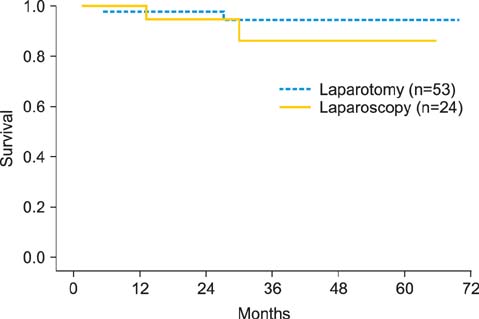J Gynecol Oncol.
2014 Apr;25(2):111-117. 10.3802/jgo.2014.25.2.111.
Comparison of laparoscopy and laparotomy for the management of early-stage ovarian cancer: surgical and oncological outcomes
- Affiliations
-
- 1Department of Obstetrics and Gynecology, Cheil General Hospital and Women's Healthcare Center, Kwandong University College of Medicine, Seoul, Korea. oncolim@korea.com
- 2Department of Radiology, Cheil General Hospital and Women's Healthcare Center, Kwandong University College of Medicine, Seoul, Korea.
- KMID: 1708333
- DOI: http://doi.org/10.3802/jgo.2014.25.2.111
Abstract
OBJECTIVE
To investigate the surgical and oncological outcomes of laparoscopic surgery compared with laparotomy for the treatment of early-stage ovarian cancer.
METHODS
Data from patients who underwent surgical management for early-stage ovarian cancer between 2006 and 2012 were retrospectively reviewed. All patients presented with stage I or II disease, and underwent comprehensive staging surgery consisting of a total hysterectomy, bilateral salpingo-oophorectomy, pelvic and para-aortic lymphadenectomy, omentectomy, and peritoneal cytology.
RESULTS
Seventy-seven patients who underwent laparoscopic surgery (24 patients) or laparotomy (53 patients) were identified. Surgery for none of the patients was converted from laparoscopy to laparotomy. The mean operation time was shorter and the estimated blood loss was lower in the laparoscopy group than in the laparotomy group, though the differences were not statistically significant (193 min vs. 224 min, p=0.127; 698 mL vs. 973 mL, p=0.127). There were no differences in the intraoperative or postoperative complications. During a mean follow-up period of 31 months, tumor recurrence occurred in 4 patients: 2 (8.3%) in the laparoscopy group and 2 (3.8%) in the laparotomy group. The mean disease-free survival was 59 months after laparoscopy and 66 months after laparotomy (p=0.367).
CONCLUSION
Laparoscopic surgery seems to be adequate and feasible for the treatment of early-stage ovarian cancer with comparable results to laparotomy in terms of the surgical outcomes and oncological safety.
MeSH Terms
Figure
Cited by 1 articles
-
Performance of pre-treatment 18F-fluorodeoxyglucose positron emission tomography/computed tomography for detecting metastasis in ovarian cancer: a systematic review and meta-analysis
Sangwon Han, Sungmin Woo, Chong Hyun Suh, Jong Jin Lee
J Gynecol Oncol. 2018;29(6):. doi: 10.3802/jgo.2018.29.e98.
Reference
-
1. Yuen PM, Yu KM, Yip SK, Lau WC, Rogers MS, Chang A. A randomized prospective study of laparoscopy and laparotomy in the management of benign ovarian masses. Am J Obstet Gynecol. 1997; 177:109–114.2. Gowri V, Koliyadan SV, Al Hamdani A, Al Kindy N. Successful term pregnancies after laparoscopic excision of poorly differentiated Sertoli-Leydig cell tumor of the ovary. J Gynecol Oncol. 2012; 23:201–204.3. Yoon A, Kim TJ, Lee WS, Kim BG, Bae DS. Single-port access laparoscopic staging operation for a borderline ovarian tumor. J Gynecol Oncol. 2011; 22:127–130.4. Querleu D, LeBlanc E. Laparoscopic infrarenal paraaortic lymph node dissection for restaging of carcinoma of the ovary or fallopian tube. Cancer. 1994; 73:1467–1471.5. Nezhat FR, Ezzati M, Chuang L, Shamshirsaz AA, Rahaman J, Gretz H. Laparoscopic management of early ovarian and fallopian tube cancers: surgical and survival outcome. Am J Obstet Gynecol. 2009; 200:83.e1–83.e6.6. Maneo A, Vignali M, Chiari S, Colombo A, Mangioni C, Landoni F. Are borderline tumors of the ovary safely treated by laparoscopy? Gynecol Oncol. 2004; 94:387–392.7. Childers JM, Aqua KA, Surwit EA, Hallum AV, Hatch KD. Abdominal-wall tumor implantation after laparoscopy for malignant conditions. Obstet Gynecol. 1994; 84:765–769.8. Medeiros LR, Rosa DD, Bozzetti MC, Rosa MI, Edelweiss MI, Stein AT, et al. Laparoscopy versus laparotomy for FIGO Stage I ovarian cancer. Cochrane Database Syst Rev. 2008; (4):CD005344.9. Lawrie TA, Medeiros LR, Rosa DD, da Rosa MI, Edelweiss MI, Stein AT, et al. Laparoscopy versus laparotomy for FIGO stage I ovarian cancer. Cochrane Database Syst Rev. 2013; 2:CD005344.10. Lee M, Kim SW, Paek J, Lee SH, Yim GW, Kim JH, et al. Comparisons of surgical outcomes, complications, and costs between laparotomy and laparoscopy in early-stage ovarian cancer. Int J Gynecol Cancer. 2011; 21:251–256.11. Ghezzi F, Cromi A, Uccella S, Bergamini V, Tomera S, Franchi M, et al. Laparoscopy versus laparotomy for the surgical management of apparent early stage ovarian cancer. Gynecol Oncol. 2007; 105:409–413.12. Park JY, Kim DY, Suh DS, Kim JH, Kim YM, Kim YT, et al. Comparison of laparoscopy and laparotomy in surgical staging of early-stage ovarian and fallopian tubal cancer. Ann Surg Oncol. 2008; 15:2012–2019.13. Romagnolo C, Gadducci A, Sartori E, Zola P, Maggino T. Management of borderline ovarian tumors: results of an Italian multicenter study. Gynecol Oncol. 2006; 101:255–260.14. Heitz F, Ognjenovic D, Harter P, Kommoss S, Ewald-Riegler N, Haberstroh M, et al. Abdominal wall metastases in patients with ovarian cancer after laparoscopic surgery: incidence, risk factors, and complications. Int J Gynecol Cancer. 2010; 20:41–46.15. Park JY, Bae J, Lim MC, Lim SY, Seo SS, Kang S, et al. Laparoscopic and laparotomic staging in stage I epithelial ovarian cancer: a comparison of feasibility and safety. Int J Gynecol Cancer. 2008; 18:1202–1209.
- Full Text Links
- Actions
-
Cited
- CITED
-
- Close
- Share
- Similar articles
-
- Laparoscopic Conservative Surgery of One Case of Ovarian Pregnancy
- Comparison of single-port laparoscopy and laparotomy in early ovarian cancer surgical staging
- Two cases of peritoneal tuberculosis mimicking ovarian carcinoma diagnosed with laparoscopy
- A Comparative Study of Laparoscopy and Laparotomy for the Management of Ovarian Dermoid Cyst
- Follow up Study of Second Look Laparotomy in Ovarian Cancer patients


